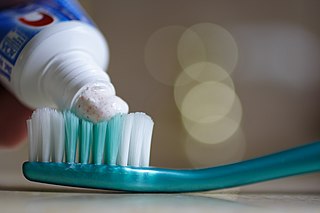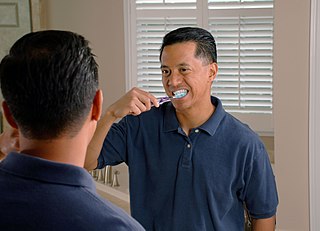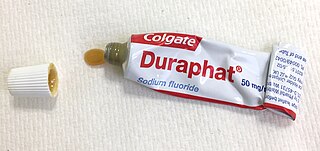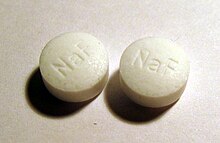
Mouthwash, mouth rinse, oral rinse, or mouth bath is a liquid which is held in the mouth passively or swirled around the mouth by contraction of the perioral muscles and/or movement of the head, and may be gargled, where the head is tilted back and the liquid bubbled at the back of the mouth.

Toothpaste is a paste or gel dentifrice used with a toothbrush to clean and maintain the aesthetics and health of teeth. Toothpaste is used to promote oral hygiene: it is an abrasive that aids in removing dental plaque and food from the teeth, assists in suppressing halitosis, and delivers active ingredients to help prevent tooth decay and gum disease (gingivitis). Owing to differences in composition and fluoride content, not all toothpastes are equally effective in maintaining oral health. The decline of tooth decay during the 20th century has been attributed to the introduction and regular use of fluoride-containing toothpastes worldwide. Large amounts of swallowed toothpaste can be poisonous. Common colors for toothpaste include white and blue.
Fluoride is an inorganic, monatomic anion of fluorine, with the chemical formula F−
, whose salts are typically white or colorless. Fluoride salts typically have distinctive bitter tastes, and are odorless. Its salts and minerals are important chemical reagents and industrial chemicals, mainly used in the production of hydrogen fluoride for fluorocarbons. Fluoride is classified as a weak base since it only partially associates in solution, but concentrated fluoride is corrosive and can attack the skin.

Tooth decay, also known as cavities or caries, is the breakdown of teeth due to acids produced by bacteria. The cavities may be a number of different colors from yellow to black. Symptoms may include pain and difficulty with eating. Complications may include inflammation of the tissue around the tooth, tooth loss and infection or abscess formation.

Water fluoridation is the controlled adjustment of fluoride to a public water supply solely to reduce tooth decay. Fluoridated water contains fluoride at a level that is effective for preventing cavities; this can occur naturally or by adding fluoride. Fluoridated water operates on tooth surfaces: in the mouth, it creates low levels of fluoride in saliva, which reduces the rate at which tooth enamel demineralizes and increases the rate at which it remineralizes in the early stages of cavities. Typically a fluoridated compound is added to drinking water, a process that in the U.S. costs an average of about $1.26 per person-year. Defluoridation is needed when the naturally occurring fluoride level exceeds recommended limits. In 2011, the World Health Organization suggested a level of fluoride from 0.5 to 1.5 mg/L, depending on climate, local environment, and other sources of fluoride. Bottled water typically has unknown fluoride levels.

Fluoride or fluorine deficiency is a disorder which may cause increased dental caries and possibly osteoporosis, due to a lack of fluoride in diet. Common dietary sources of fluoride include tea, grape juice, wine, raisins, some seafood, coffee, and tap water that has been fluoridated. The extent to which the condition truly exists, and its relationship to fluoride poisoning has given rise to some controversy. Fluorine is not considered to be an essential nutrient, but the importance of fluorides for preventing tooth decay is well-recognized, despite the effect is predominantly topical. Prior to 1981, the effect of fluorides was thought to be largely systemic and preeruptive, requiring ingestion. Fluoride is considered essential in the development and maintenance of teeth by the American Dental Hygienists' Association. Fluoride incorporates into the teeth to form and harden teeth enamels. This makes the teeth more acid resistant, as well as more resistant to cavity forming bacteria. Caries-inhibiting effects of fluoride were first noticed 1902, when fluoride in high concentrations was found to stain teeth and prevent tooth decay.

Abrasion is the non-carious, mechanical wear of tooth from interaction with objects other than tooth-tooth contact. It most commonly affects the premolars and canines, usually along the cervical margins. Based on clinical surveys, studies have shown that abrasion is the most common but not the sole aetiological factor for development of non-carious cervical lesions (NCCL) and is most frequently caused by incorrect toothbrushing technique.

Acid erosion is a type of tooth wear. It is defined as the irreversible loss of tooth structure due to chemical dissolution by acids not of bacterial origin. Dental erosion is the most common chronic condition of children ages 5–17, although it is only relatively recently that it has been recognised as a dental health problem. There is generally widespread ignorance of the damaging effects of acid erosion; this is particularly the case with erosion due to consumption of fruit juices because they tend to be considered as healthy. Acid erosion begins initially in the enamel, causing it to become thin, and can progress into dentin, giving the tooth a dull yellow appearance and leading to dentin hypersensitivity.

Dental fluorosis is a common disorder, characterized by hypomineralization of tooth enamel caused by ingestion of excessive fluoride during enamel formation.

Early childhood caries (ECC), formerly known as nursing bottle caries, baby bottle tooth decay, night bottle mouth and night bottle caries, is a disease that affects teeth in children aged between birth and 71 months. ECC is characterized by the presence of 1 or more decayed, missing, or filled tooth surfaces in any primary tooth. ECC has been shown to be a very common, transmissible bacterial infection, usually passed from the primary caregiver to the child. The main bacteria responsible for dental caries are Streptococcus mutans and Lactobacillus. There is also evidence that supports that those who are in lower socioeconomic populations are at greater risk of developing ECC.

Henry Trendley Dean was the first director of the United States National Institute of Dental Research and a pioneer investigator of water fluoridation in the prevention of tooth decay.

Tin(II) fluoride, commonly referred to commercially as stannous fluoride (from Latin stannum, 'tin'), is a chemical compound with the formula SnF2. It is a colourless solid used as an ingredient in toothpastes.

Tooth brushing is the act of scrubbing teeth with a toothbrush equipped with toothpaste. Interdental cleaning can be useful with tooth brushing, and together these two activities are the primary means of cleaning teeth, one of the main aspects of oral hygiene. The recommended amount of time for tooth brushing is two minutes.
Olaflur is a fluoride-containing substance that is an ingredient of toothpastes and solutions for the prevention of dental caries. It has been in use since 1966. Especially in combination with dectaflur, it is also used in the form of gels for the treatment of early stages of caries, sensitive teeth, and by dentists for the refluoridation of damaged tooth enamel.

Dental Public Health (DPH) is a para-clinical specialty of dentistry that deals with the prevention of oral disease and promotion of oral health. Dental public health is involved in the assessment of key dental health needs and coming up with effective solutions to improve the dental health of populations rather than individuals.

Oral hygiene is the practice of keeping one's oral cavity clean and free of disease and other problems by regular brushing of the teeth and adopting good hygiene habits. It is important that oral hygiene be carried out on a regular basis to enable prevention of dental disease and bad breath. The most common types of dental disease are tooth decay and gum diseases, including gingivitis, and periodontitis.

Fluoride varnish is a highly concentrated form of fluoride which is applied to the tooth's surface, by a dentist, dental hygienist or other health care professional, as a type of topical fluoride therapy. It is not a permanent varnish but due to its adherent nature it is able to stay in contact with the tooth surface for several hours. It may be applied to the enamel, dentine or cementum of the tooth and can be used to help prevent decay, remineralise the tooth surface and to treat dentine hypersensitivity. There are more than 30 fluoride-containing varnish products on the market today, and they have varying compositions and delivery systems. These compositional differences lead to widely variable pharmacokinetics, the effects of which remain largely untested clinically.

Water fluoridation is the controlled addition of fluoride to a public water supply to reduce tooth decay, and is handled differently by country. Fluoridated water has fluoride at a level that is proven effective for preventing cavities; this can occur naturally or by adding fluoride. Fluoridated water operates on tooth surfaces: in the mouth it creates low levels of fluoride in saliva, which reduces the rate at which tooth enamel demineralizes and increases the rate at which it remineralizes in the early stages of cavities. Typically a fluoridated compound is added to drinking water, a process that in the U.S. costs an average of about $1.26 per person-year. Defluoridation is needed when the naturally occurring fluoride level exceeds recommended limits. In 2011 the World Health Organization suggested a level of fluoride from 0.5 to 1.5 mg/L, depending on climate, local environment, and other sources of fluoride. Bottled water typically has unknown fluoride levels.

Tooth remineralization is the natural repair process for non-cavitated tooth lesions, in which calcium, phosphate and sometimes fluoride ions are deposited into crystal voids in demineralised enamel. Remineralization can contribute towards restoring strength and function within tooth structure.
Topical fluorides are fluoride-containing drugs indicated in prevention and treatment of dental caries, particularly in children's primary dentitions. The dental-protecting property of topical fluoride can be attributed to multiple mechanisms of action, including the promotion of remineralization of decalcified enamel, the inhibition of the cariogenic microbial metabolism in dental plaque and the increase of tooth resistance to acid dissolution. Topical fluoride is available in a variety of dose forms, for example, toothpaste, mouth rinses, varnish and silver diamine solution. These dosage forms possess different absorption mechanisms and consist of different active ingredients. Common active ingredients include sodium fluoride, stannous fluoride, silver diamine fluoride. These ingredients account for different pharmacokinetic profiles, thereby having varied dosing regimes and therapeutic effects. A minority of individuals may experience certain adverse effects, including dermatological irritation, hypersensitivity reactions, neurotoxicity and dental fluorosis. In severe cases, fluoride overdose may lead to acute toxicity. While topical fluoride is effective in preventing dental caries, it should be used with caution in specific situations to avoid undesired side effects.
















